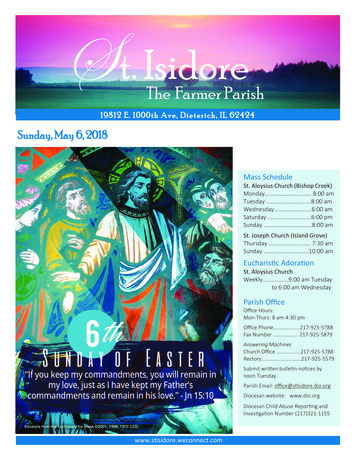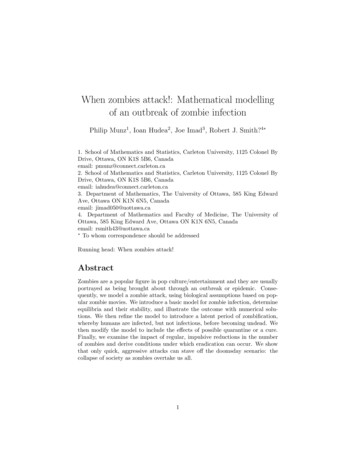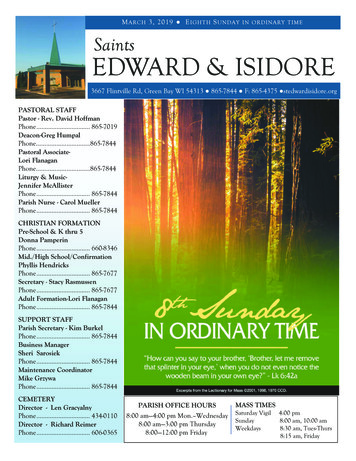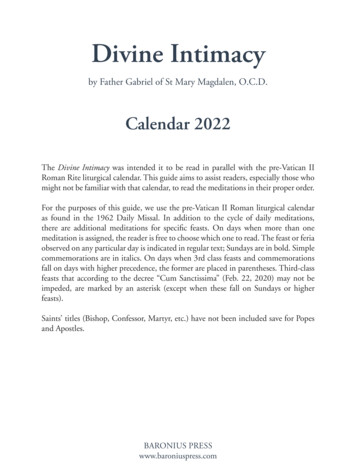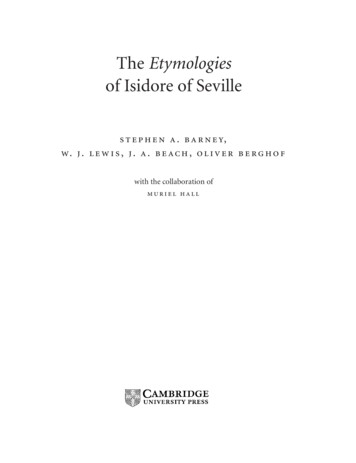
Transcription
The Etymologiesof Isidore of Sevilles t e p h e n a . ba r n e y,w. j . l e w i s , j . a . b e ac h , o l i v e r b e r g h o fwith the collaboration ofmuriel hall
ContentsAcknowledgements page ixNote to the reader xiintroductionIntroductionHistorical backgroundChronologyLife and worksThe sources of the EtymologiesThe character of the EtymologiesThe influence of the EtymologiesEditions of the Etymologies and thistranslationBibliography34671017242729t h e e t y m o lo g i e sAnalytical table of contentsbook iGrammarbook iiRhetoric and dialecticbook iiiMathematics, music, astronomybook ivMedicinebook vLaws and timesbook viBooks and ecclesiastical officesbook vii God, angels, and saintsbook viii The Church and sectsbook ixLanguages, nations, reigns, the military,citizens, family relationshipsbook xVocabularybook xiThe human being and portentsbook xii Animalsbook xiii The cosmos and its partsbook xiv The earth and its partsbook xv Buildings and 301
viii s and metalsRural mattersWar and gamesShips, buildings, and clothingProvisions and various implements317337359373395appendixCorrespondence of Isidore and Braulio409i n d e xe sGeneral index 417Index of Greek wordsIndex of citations 469465
IntroductionWe are pleased to present the first complete Englishtranslation from the Latin of Isidore’s Etymologies.Isidore, Bishop of Seville, compiled the Etymologies (alsoknown as the Origins) in the late teens and twenties ofthe seventh century, and left it nearly complete at hisdeath in 636. In the form of an encyclopedia, it containsa compendium of much of the essential learning of theancient Greco-Roman and early Christian worlds. In hisimportant study of the Latin literary culture of medievalEurope, Ernst Robert Curtius spoke of the Etymologies asserving “the entire Middle Ages as a basic book.”1 It wasarguably the most influential book, after the Bible, in thelearned world of the Latin West for nearly a thousandyears.To get an idea of what a seventh-century Irish monk,or a lecturer at a cathedral school in the eleventh century, or an Italian poet of the fourteenth century, or alexicographer of the sixteenth century could learn fromthe Etymologies, one might pick a bit of lore from eachof the twenty books in which the work has come downto us. From Isidore, then, we learn that:r Caesar Augustus used a code in which he replacedeach letter with the following letter of the alphabet,b for a, etc. (I.xxv.2).r Plato divided physics into four categories: arithmetic,geometry, music, and astronomy (II.xxiv.4).r The term ‘cymbal’ derives from the Greek words for“with” and “dancing,” and (III.xxii.12).r A physician needs to know the Seven Liberal Arts ofGrammar, Rhetoric, Dialectic, Arithmetic,Geometry, Music, and Astronomy (IV.xiii.1–4.)r In ancient times execution by sword was preferred asspeedier (V.xxvii.35).1 “Grundbuch des ganzen Mittelalters,” in Europäische Literaturund lateinisches Mittelalter (Bern, 1948), trans. by W. R. Trask, European Literature and the Latin Middle Ages (New York, 1953: 23).3r Architects use green Carystean marble to panellibraries, because the green refreshes weary eyes(VI.xi.2).r Esau had three names, meaning “red” (for the stewhe made), “bloody” (for his complexion), and“hairy” (VII.vi.33–34).r Aristotle says that Zoroaster, the first magician,composed two million verses (VIII.ix.1).r A soldier (miles) is so called because oncethere were a thousand (mille) in one troop(IX.iii.32).r The word for a garrulous person (garrulus) derivesfrom the name of the constantly chattering bird, thejackdaw (graculus) (X.114).r In the womb, the knees (genua) are pressed againstthe face, and help to form the eye-sockets (genae);hence their name (XI.i.108).r The ibis purges itself by spewing water into its anuswith its beak (XII.vii.33).r Because of its brightness, lightning reaches the eyesbefore thunder reaches the ears (XIII.viii.2).r Gaul is so named from the whiteness of its people,for “milk” in Greek is (XIV.iv.25).r Minerva is ‘Athena’ in Greek; she is reputed to beinventor of many arts because various arts, andphilosophy itself, consider the city of Athens theirtemple (XV.i.44).r Amber is not the sap of the poplar, but of pine,because when burned it smells like pine pitch(XVI.viii.6).r An altar was dedicated in Rome to Stercutus, whobrought the technique of dunging (stercorare) fieldsto Italy (XVII.i.3).r The battering ram takes its name ‘ram’ from itscharacter, because it butts walls (XVIII.xi.1).r The women of Arabia and Mesopotamia wear theveil called theristrum even today as a protection fromheat (XIX.xxv.6).r Wine (vinum) is so called because it replenishes theveins (vena) with blood (XX.ii.2).
4 introductionIn the following introduction we provide sketches ofIsidore’s historical setting, of his life and works, of thesources of the Etymologies, of the character of the work,and of its influence.2Historical backgroundWhen Isidore was born around the middle of the sixthcentury, the Western Roman Empire no longer existedas a political entity. Gaul was now ruled by the Franks,and in Italy the Ostrogoths had just been defeated byByzantine forces, who had also taken over North Africafrom the Vandals a short time earlier. Spain, meanwhile,had been under Visigothic rule for over a century.3The Visigoths, like the Ostrogoths, were a Germanicpeople, originally settled north of the Danube. In 376,under increasing pressure from the Huns, they wereallowed by Roman authorities to cross the Danube andsettle in Thrace. Their dealings with Rome within theEmpire were rocky from the outset, and they soonrebelled, raiding throughout Thrace before defeatingRoman forces outside Adrianople in 378. Fighting continued until the two sides reached an agreement in 382which established the Visigoths as Roman allies boundto supply troops in return for subsidies and a certainamount of autonomy. By the end of the century relations had deteriorated again, however, and the Visigoths,led by Alaric (reigned 395–410), entered Italy and sackedRome in 410 after they were unable to reach an agreement with the Emperor on the subsidies they were toreceive. Still at odds with the Romans, they made theirway to Southern Gaul in 412, and from there were drivenby Emperor Constantius into Spain.The Roman province of Hispania had been overrun afew years previous to this by a loose alliance of Germanictribes, the Alans, the Vandals, and the Sueves. The Visigoths, faced with food shortages due to a Roman blockade, came to an agreement with Constantius to fightthese earlier barbarian invaders on Rome’s behalf. Aftersome success, they were resettled in Gaul in 418.In 456, under Theodoric II (reigned 453–466),the Visigoths invaded Spain again, where the Suevihad become the dominant power in the meantime.Theodoric’s forces did not manage to conquer the entirepeninsula, however; areas held by the Suevi, Galiciansand others continued to assert their independence forsome time, and the Basque territories were never completely subdued.In 507, Clovis, the king of the Franks, attacked theGaulish part of the Visigothic kingdom, and over thenext quarter century the Visigoths lost all their Gaulish territory apart from the region around Narbonneknown as Septimania. From this point on, the Visigothic kingdom was essentially confined to the Spanishpeninsula.It should be pointed out that although the Visigoths were rulers of Spain they probably only made upa small percentage of the population throughout theperiod under their rule; the majority of the inhabitantswere Hispano-Roman. The new rulers retained a largepart of the Roman administrative structure; Roman governors and officials continued to collect at least someRoman taxes4 and enforce Roman law.5 The two groupsremained socially distinct, however; a ban from imperialtimes on intermarriage between Goths and Romans, forexample, apparently remained in effect until the laterpart of the sixth century.6Visigothic Spain was a politically unstable kingdomthroughout most of the sixth century. Four successivekings were murdered (Amalric, Theudis, Theudisclus,and Agila). From 544, Byzantine forces intervened inVisigothic affairs, possibly at the invitation of Athanagild in his rebellion against Agila. By 557, the Byzantines occupied the southeastern coast of the peninsula,including the port city of Cartagena. Isidore’s parentsappear to have left Cartagena at about this time, quitepossibly as a result of this invasion. In the meantime,2 The fullest recent account of all these matters is the extensiveGeneral Introduction by Manuel C. Dı́az y Dı́az to the Spanishedition of the Etymologies, ed. Oroz Reta and Marcos Casquero 19932 :3–257. No good general treatment of Isidore is available in English;the study by Brehaut (1912) is outdated.3 For a recent overview of the whole period see McKitterick 2001.4 Land tax, custom tolls, and collatio lustralis continued to becollected, for example; see Heather 1996: 194–95.5 There is some controversy over whether the Gothic inhabitantswere subject to a separate code based on traditional Gothic law; see,among others, King 1980, Collins 1995: 24–31, Heather 1996: 194–96,Velázquez 1999, and Wood 1999.6 Wood 1999: 193.
Historical background 5relations with the Franks to the north deteriorated andthey began to threaten Visigothic Septimania and theEbro Valley.Following Athanagild’s death in 568, the Visigothicnobility chose Liuva to be king, and after Liuva’s deathin 571 or 573, his brother Leovigild (the Visigothic monarchy was not hereditary, although sometimes a son didsucceed his father to the throne). Under Leovigild, thekingdom saw its strength increase. The new king’s military successes restored territory that had been lost to theByzantines and regained political control over rebelliousareas (the city of Cordoba, for example, which had beenin a state of rebellion since 550) and bordering regionsin the northern part of the peninsula.Leovigild’s attempt to win new converts to Arianismmet with less success. Arianism was a form of Christianity that held that the three members of the Trinity were not equal and co-eternal – specifically that theSon was not God by nature but created, and not eternallike the Father.7 Catholic Christians condemned Ariandoctrine as heresy at the Council of Nicaea in 325. TheGoths, however, had already accepted Arianism whenthey converted to Christianity, and they continued tohold this doctrine as they moved westward into Gauland then into Spain. Until Leovigild, the Gothic rulershad made no attempt to convert their largely Catholicsubjects, and had apparently made little restriction onthe practice of Catholicism, although the Catholic clergyhad been deprived of some of their privileges. Under theArian rulers, the Catholic Church in Spain had been freeto convene synods, construct new churches and foundmonasteries, correspond with the Pope, and circulatetheir writings openly. The two Churches coexisted independently of each other, each with its own clergy, shrines,and other institutions.7 For a discussion of the theology of Gothic Arianism see Wiles1996:45–51.8 Some historians have suggested that the Franks first convertedfrom paganism to Arianism, and then from Arianism to Catholicism;see D. Schanzer, “Dating the Baptism of Clovis: the Bishop of Viennevs. the Bishop of Tours,” Early Medieval Europe 7 (1998): 29–57.9 Dialogues, iii.31. See Collins 1980:215–18 for further discussionof Leander’s role in Hermenigild’s conversion.10 Collins 1995:54.11 See Stocking 2000:59–88 for a discussion of the Council; recordsof the Council may be found in G. Martı́nez Dı́ez and F. Rodrı́guez,eds., La Coleccı́on Canónica Hispana, V, Concilios Hispanos: segundaparte (Madrid, 1992).Leovigild, however, mounted a serious campaign toexpand Arianism, choosing persuasion and rewards ashis instruments, rather than force. In 580 he summonedthe first Arian synod held in Spain, and ruled that converts to Arianism no longer needed to be rebaptized,which presumably also made the process of conversion more appealing to Catholics. According to Gregory of Tours (Libri Historiarum X, 6.18), Leovigild alsoattempted to win converts by redefining Arian doctrineto hold that the Father and Son were equal and co-eternaland only the Holy Spirit was not equal. Although hemanaged to win over a few important Catholic figures,including the Bishop of Saragossa, he lost ground in hisown family, for by 582 his older son Hermenigild hadconverted to Catholicism.Hermenigild’s conversion may have been based asmuch on political considerations as religious conviction. He had rebelled against his father in 579, soon afterhis marriage to a Frankish princess (Clovis, the king ofthe Franks, had converted to Catholicism around thebeginning of the sixth century),8 and had declared himself the independent monarch over the southern part ofthe peninsula. For three years, Leovigild seems to haveaccepted the situation, making no attempt to regain control, while Hermenigild, for his part, did not seek toexpand the territory under his rule. Some time around582, Hermenigild converted to Catholicism, under theinfluence of Isidore’s brother Leander, according to PopeGregory I, a friend of Leander.9In 583, Leovigild finally moved to retake the territory held by Hermenigild, and by 584 he had regainedcontrol and exiled Hermenigild to Valencia, where hewas murdered the next year. Leovigild, in the meantime,continued his military successes, conquering the Suevickingdom before he died in 586.Reccared, Leovigild’s other son and Hermenigild’syounger brother, became king at his father’s death, andconverted to Catholicism the following year. Again, aswith Hermenigild, Leander of Seville was apparentlyinstrumental in his conversion10 . Reccared began systematically disassembling the Arian Church structure,reassigning Arian churches to the Catholic dioceseswhere they were located, and allowing Arian bishopswho converted to retain their sees, even when this meanthaving two bishops in a single see. Most of the groundwork for these changes was laid at the kingdom-widechurch Council convened by Reccared at Toledo in 589.11
6 introductionAlthough he ordered the destruction of Arian books(and in fact no Arian documents are preserved fromVisigothic Spain), there was little if any other persecution of Arians who refused to convert. In the first fouryears following his conversion, Reccared faced severalArian conspiracies and attempted revolts led by Gothicnobles, but these did not turn out to be serious threats,and within a generation Arianism appears to havedied out.One result of Reccared’s conversion to Catholicismwas the formation of close ties between the monarchyand the Church. From this point forward, the Visigothickings exercised control over the appointment of bishopsand other decisions that had hitherto been made by theChurch alone (see Letters IV and V in the Appendix). Inreturn, the Church, in particular the council of bishops,was given the authority and responsibility for overseeingsecular offices like local judges and agents of the treasuryestates.Reccared died in 601, shortly after Isidore becameBishop of Seville, and was succeeded by his seventeenyear-old illegitimate son Liuva II. Less than two yearslater, Liuva was deposed by Witteric, a Gothic noble. Witteric had Liuva’s right hand cut off to prevent him fromretaking the throne (Visigothic tradition required thatthe monarch be able-bodied), and then, in 603, had himexecuted. Witteric himself was assassinated in 610. Theassassins and their motivations have not been recorded,but Witteric was by all accounts not a popular king.Isidore speaks of him with disapproval, and other contemporaries complained of injustices suffered under hisrole. Gundemar took the throne after Witteric’s death,and involved himself, as Reccared had, in the councils ofbishops, before dying two years later.Sisebut then became king. He was a man of some intellectual attainment and authored, among other works, apoem on lunar eclipses (written in 613 as a responseto Isidore’s cosmological treatise, De Natura Rerum)and a Life of St. Desiderius of Vienne.12 He was alsonoted by contemporaries for his personal piety, whichled him to become deeply involved in the activities ofthe Church. According to Isidore, Sisebut’s anti-Jewishpolicy of forced conversion was based on zeal ratherthan knowledge.13 (Isidore may be referring to this campaign in Etymologies V.xxxix.42.) Isidore did not entirelyapprove of this policy but apparently reserved his criticism until after Sisebut’s death.Sisebut died in 621, of natural causes, or an overdose ofmedicine, or deliberate poisoning, depending on whichaccount one credits.14 Reccared II, his young son andsuccessor, died shortly thereafter, and Suinthila took thethrone. He began his reign by pushing back a Basqueincursion into the province of Tarragona (see Letter II).A further triumph followed a few years later when hesucceeded in driving the Byzantines out of Spain. Inone version of the Historia Gothorum, written duringSuinthila’s reign, Isidore is lavish in his praise of themonarch. However, Suinthila was deposed in 631 by agroup of nobles with Frankish assistance, and Sisenandwas made king. Little is recorded about Sisenand’s reignaside from his participation in the Fourth Council ofToledo. He died in 636, the same year as Isidore.Chronology557: Byzantines occupy Cartagena.ca. 560: Isidore is born.572: Leovigild becomes king.ca. 579: Hermenigild rebels.586: Death of Leovigild; Reccared becomes king.587: Reccared converts to Catholicism.600: Leander dies. Isidore becomes Archbishop ofSeville.601/2: Reccared dies. Liuva II becomes king.603: Witteric dethrones and murders Liuva II, andbecomes king.610: Witteric assassinated. Gundemar becomesking.12 See J. Fontaine, “King Sisebut’s Vita Desiderii and the PoliticalFunction of Visigothic Hagiography,” in James 1980.13 Isidore, History of the Goths, 61, translated in Wolf 1999:105; seeStocking 2000:132–6 for further discussion of Sisebut’s and Isidore’sviews on conversion.14 Isidore, History of the Goths in Wolf 1999:106: “Some claim thathe died a natural death, others, that he died as a result of an overdoseof some medication.” In an earlier version of the History of the Goths,the possibility of poisoning was mentioned (see Stocking 2000:135fn. 69).
Life and works 7611/12: Death of Gundemar. Sisebut becomes king.613: Isidore dedicates De Natura Rerum to Sisebut.621: Sisebut dies. Reccared II becomes king and diesshortly thereafter. Suinthila becomes king.624: Suinthila drives the Byzantines completely out ofSpain.631: Suinthila is deposed. Sisenand becomes king.636: Sisenand dies. Isidore dies.Life and worksFew details can be given about Isidore’s life with anycertainty. He was born some time around 560, about thetime when his father Severianus relocated the family toSeville from Cartagena, where invading Byzantine forceshad taken control. Isidore’s parents died while he was stillyoung, and he was brought up and educated in Sevilleunder the care of his older brother Leander, very likely inthe monastery school where Leander was abbot (Riché1976:289).Leander, who became Bishop of Seville before 580,was an active and influential churchman.15 He was a personal friend of Gregory, later Pope Gregory I, whom heencountered on a visit to Constantinople and who dedicated his Moralia to Leander. A connection of greaterconsequence for the kingdom of Spain was Leander’sfriendship with King Leovigild’s sons Hermenigild andReccared, the future king; it was under Leander’s guidance that both his royal friends converted from Arianismto Catholicism.After Leander’s death, and shortly before Reccareddied, Isidore was made Bishop of Seville, most likely in15 Good biographies of Leander, with accounts of his combatagainst Arianism and his writings, are L. Navarra, Leandro di Siviglia:Profilo storico-letterario (Rome, 1987), which prints and translates hisHomilia in Laudem Ecclesiae, and J. Madoz, “San Leandro de Sevilla,”Estudios Eclesiásticos 56 (1981): 415–53, printing the basic documentary sources for Leander’s career.16 The kind of Greek known by Isidore and others from the sixthcentury on has been the subject of a number of studies: see Bischoff1967:246–75, Riché 1976:44–45, W. Berschin, Griechisch-lateinischesMittelalter, von Hieronymus zu Nikolaus von Kues (Bern and Munich,1980), revised and expanded by the author and trans. J. C. Frakes asGreek Letters and the Latin Middle Ages, from Jerome to Nicholas ofCusa (Washington, DC, 1988) and especially M. Herren and S. A.Brown, eds., The Sacred Nectar of the Greeks: The Study of Greekin the West in the Early Middle Ages (London, 1988), esp. Herren’sintroduction (v–xii), and the studies by Dionisotti (1–56), Herren(57–84), Berschin (85–104), and Riché (143–68) in the same volume.Isidore’s knowledge of Hebrew was restricted to names interpretedby Jerome (Riché 1976:302).the year 600. His other brother, Fulgentius, as well as hissister Florentina, also chose to go into the Church; Fulgentius became Bishop of Ecija and Florentina entered anunnery. As one of the leading churchmen in the country, Isidore presided over important Church councils inSeville (in 619) and Toledo (in 633). The close ties that hadbeen established between the Visigothic monarchy andthe Catholic Church after Reccared’s conversion make itlikely that Isidore had some political influence as well.His relationship with King Sisebut (reigned 612–621) wasparticularly close, extending beyond practical matters ofgovernment to a personal friendship based on sharedintellectual interests. Also important was his friendshipwith his younger colleague, Braulio, who was in Sevillewith Isidore until 619, when he became archdeacon (andlater, in 631, bishop) of the Church in Saragossa. Theircorrespondence (see the letters attached to the Etymologies in the Appendix) provides a valuable glimpse ofIsidore’s personality and daily life.Isidore was deeply admired by his contemporariesfor his scholarship and intellectual gifts. Although theirpraise for his Greek and Hebrew is perhaps unmerited (his knowledge of these languages appears to haveextended only to disconnected Greek terms and phrases,and a smattering of Hebrew words), the breadth of hislearning is nonetheless impressive.16 He was happy todraw on pagan authors as well as Church Fathers, andwas familiar with works as various as Martial’s Epigrams,Tertullian’s On Spectacles, and Pliny the Elder’s NaturalHistory. In spite of the demands of his episcopal office,Isidore nevertheless found time to produce a substantial body of writing. Braulio compiled a list of theseworks, the Renotatio Isidori, presented in the order inwhich they were written, shortly after Isidore’s deathin 636:Isidore, an excellent man, bishop of the Church atSeville, successor to and brother of Bishop Leander,flourished from the time of the Emperor Mauritius and
8 introductionKing Reccared.17 Our own time indeed found in him alikeness to the knowledge of antiquity, and in himantiquity reclaimed something for itself. He was a maneducated in every kind of expression, so that in thequality of his speech he was suited to both the ignorantaudience and the learned. Indeed, he was famous for hisincomparable eloquence, eloquence appropriate to theoccasion. An intelligent reader can now very easilyunderstand from his diverse undertakings andwell-crafted works just how great Isidore’s knowledgewas. Accordingly, I have noted down these thoughtsabout the works that have come to my notice. Hepublished:Two books of Differences (Differentiae), in which heused subtle distinctions to differentiate the meaningof terms whose use is confused.One book of Introductions (Proemia), in which throughbrief notes he pointed out what each book of HolyScripture contains.One book On the Lives and Deaths of the Fathers (De Ortuet Obitu Patrum), in which he noted with thoughtfulbrevity their deeds and worthiness, their deaths andburials.Two books of Offices (Officia), for his brother Fulgentius,Bishop of Ecija, in which he set out the origin of theOffices and why each Office is performed in the Churchof God, with interpretations of his own pen, but notwithout the authority of our forefathers.Two books of Synonyms (Synonyma), with which, throughthe intervening exhortation of reason, he encouragedthe reader to a consolation of the soul and a hope ofreceiving forgiveness.One book On the Nature of Things (De Natura Rerum),addressed to King Sisebut, in which he resolved certainobscure matters concerning the elements, relying onhis study of both the Doctors of the Church and thephilosophers.One book On Numbers (De Numeris), in which he touchedin part on the discipline of mathematics, on accountof the numbers which are inserted in Sacred Scripture.One book On the Names of the Law and the Gospels (DeNominibus Legis et Evangeliorum), in which he showswhat the people who are mentioned signify in a mystical sense.One book On Heresies (De Haeresibus), in which, following the examples of our forefathers, he gathers diversetopics, being as brief as he can.Three books of Sentences (Sententiae), which he ornamented with flowers from the book of Morals by PopeGregory.One book of Chronicles (Chronicon), from the creation ofthe world up until his own time, collected with greatbrevity.Two books Against the Jews (Contra Judaeos), at the requestof his sister Florentina, a virgin (i.e. a nun) in her wayof life, in which he demonstrated everything that theCatholic Church believes based on the evidence of theLaw and of the Prophets (i.e. based on the HebrewScriptures alone).One book On Illustrious Men (De Viris Illustribus), towhich we are adding this entry.18One book of the Monastic Rule (Monastica Regula), whichhe tempered most fittingly for use in this country andfor the souls of the weak.One book On the Origin of the Goths, and also The Kingdomof the Suevi, and The History of the Vandals (De Origine Gothorum et Regno Suevorum et etiam VandalorumHistoria).Two books of Questions (Quaestiones), which the readermay recognize as an abundant anthology of ancienttreatises.The Etymologies (Etymologiae), a codex of enormous size,divided by him into topics, not books. Although heleft it unfinished, I divided it into twenty (or, “fifteen,”in some manuscripts) books, since he wrote the workat my request. Whoever thoughtfully and thoroughlyreads through this work, which is suited to philosophyin every respect, will not be ignorant of the knowledgeof human and divine matters, and deservedly so. Overflowing with eloquence of various arts with regard tonearly every point of them that ought to be known, itcollects them in a summarized form.There are also other minor works by this man, andabundantly ornamented writings in the Church of God.After such misfortune in Spain in recent years, Godencouraged him, as if he were setting up a prop – topreserve the ancient monuments, I believe, lest we decayinto rusticity. To him we may fittingly apply thephilosopher’s comment (Cicero, Academica Posteriora1.3): “Your books have brought us back, as if to ourhome, when we were roving and wandering in our owncity like strangers, so that we might sometimes be able tounderstand who and where we are. You have laid openthe lifetime of our country, the description of the ages,the laws of sacred matters and of priests, learning bothdomestic and public, the names, kinds, functions and17 The Byzantine Emperor Mauritius reigned from 582 to 602, andReccared from 586 to 601.18 On the De Viris Illustribus see below. Braulio’s list was appendedto a manuscript of Isidore’s treatise. It is edited from the manuscriptLeón 22 by P. Galindo, pp. 356–60 in C. H. Lynch, San Braulio(Madrid, 1950).
Life and works 9causes of settlements, regions, places, and all mattersboth human and divine.”19The proceedings of the Council at Seville, at whichhe was present, declare how with a flood of eloquence hepierced through the heresy of the Acephalites (see VIII.v. 66) with the arrows of divine Scripture and thetestimonies of the Church Fathers. In this council heasserted the truth against Gregorius, leader of theaforementioned heresy.Isidore died during the reign of the EmperorHeraclius and of the most Christian King Chintila.20 Hewas outstanding above everyone with his sounddoctrine, and very generous in his works of charity.All of these works except On Heresies (the subject ofEtymologies VIII.v) are still extant. They range in datefrom what is presumably the earliest, the first book ofthe Differentiae, around 600, to around 625. Four of themfocus closely on the Bible. The Introductions gives a briefdescription of each book of the Bible, and the On theLives and Deaths of the Fathers is a collection containing short biographies of important Biblical figures. Inspite of Braulio’s description, On Numbers is a religiousrather than mathematical treatise; in it Isidore discussesthe symbolic interpretation of numerals contained inthe text of the Bible. On the Names of the Law and theGospels, also known as the Allegories (Allegoriae), is asimilar discussion of the symbolism of Biblical names.Against the Jews is an attempt to win converts fromJudaism to Christianity by means of rational persuasion;it was most likely written around the time of King Sisebut’s campaign of forced conversion (see above, p. 6),19 Braulio would have read Cicero’s encomium of Varro, the greatpredecessor of Isidore, in Augustine’s City of God 6.2.20 The Byzantine Emperor Heraclius reigned from 610 to 641, andChintila from 636 to 640.21 Both the Chronicon (Chronica Maiora) and the shorter version (Chronica Minora) included in the Etymologies are edited byT. Mommsen, mgh, Auct. Ant. xi, 391–497 (Berlin, 1894). The newedition of the Chronica (61
book vi Books and ecclesiastical offices 135 book vii God, angels, and saints 153 book viii The Church and sects 173 book ix Languages, nations, reigns, the military, citizens, family relationships 191 book x Vo cabulary 213 book xi The human being and portents 231 book xii Animals 247 book xiii The cosmos and its parts 271

